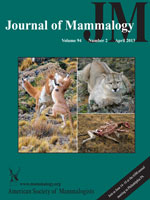We used 15 years (1992–2006) of capture–mark–recapture (CMR) data obtained from a population of nine-banded armadillos (Dasypus novemcinctus) located at the Tall Timbers Research Station near Tallahassee, Florida and multistate CMR models to estimate and model capture probabilities, annual apparent survival, and transition probabilities between reproductive and nonreproductive states (for adult females only). Using an information theoretic approach, we then examined various influences on these parameters. Across all years, capture probability, p, was higher for adults than for yearlings, and higher for males than for females. There was also substantial yearly variation. Conditional on survival, the annual transition probability, ψ, for reproductive adult females to remain reproductive was 0.853 ± 0.044; the estimate for nonreproductive adult females to become reproductive was 0.388 ± 0.060. Annual apparent survival, S, was lowest for juveniles (S = 0.541 ± 0.118) and highest for reproductive adult females (S = 0.753 ± 0.034). Contrary to expectation, these data provided no evidence for a cost of reproduction among adult females. Finally, annual apparent survival was lower for all animals during an extensive hardwood removal that occurred from 1998 to 2000 than in either preceding or subsequent years.
How to translate text using browser tools
1 April 2013
Population ecology of the nine-banded armadillo in Florida
W. J. Loughry,
Carolina Perez-Heydrich,
Colleen M. McDonough,
Madan K. Oli
ACCESS THE FULL ARTICLE

Journal of Mammalogy
Vol. 94 • No. 2
April 2013
Vol. 94 • No. 2
April 2013
apparent survival
armadillo
capture probability
costs of reproduction
Dasypus noveminctus
logging
mark–recapture analysis




